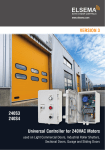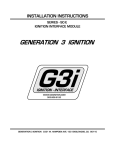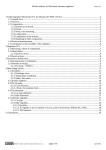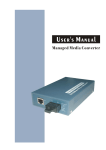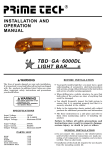Download model br/brg butt welders
Transcript
MICRO WELD MODEL BR/BRG BUTT WELDERS MICRO PRODUCTS COMPANY SERVICE MANUAL 1 TABLE OF CONTENTS 1.0 2.0 3.0 4.0 5.0 6.0 7.0 8.0 9.0 10.0 11.0 12.0 13.0 SPECIFICATIONS GENERAL OPERATING INSTRUCTIONS BASIC OPERATING PARTS BASIC OPERATING PARTS LOCATION TYPICAL OPERATING SEQUENCE SPECIAL ADJUSTMENTS PREVENTIVE MAINTENACE SUGGESTED SETTINGS DIAGNOISTIC CHART FOR TROULBE-SHOOTING ELECTRICAL SCHEMATIC SAFETY RERMINDERS BUYERS GUIDE PARTS LIST 1.0 SPECIFICATIONS Model BR/BRG Type of Welding Process Welding Range Butt welds .125 to .500 inch wide flat stock steel Material Suitability Standard Operating Voltages Steel 115 Volts Maximum Line Demand 115 Volt 9amps@100% duty cycle 29amps@10% duty cycle 1.5 KVA Maximum Hand Lever Bench Single Phase AC Transformer Clamp Method Mounting Dimensions and Weights Height Overall Bench space Weight 9 in. BR 16 in. BRG 5.5 in. x 9 in. 50 LBS – BR 60 LBS -BRG 2 FEATURES OF WELDING EQUIPMENT • • • • • Stryco quality and workmanship Heavy-duty construction & components Easy to operate controls Low maintenance costs Easy to set welding parameters • • • Sensitive straight slide movable headpiece assembly Adjustable limit switch Changeable welding dies and clamp shoes • • • • Adjustable tension Manual hand clamps Low voltage control circuits Power cord 2.0 GENERAL OPERATING INSTRUCIONS 2.1 ELECTRICAL HOOK-UP INSTRUCTIONS First determine that available electrical service in your plant corresponds to the nameplate rating located on welder housing. Electrical wiring to welder must be of sufficient size to deliver full ampere load with no appreciable loss during weld cycle. The welder will not operate properly if there is more than a 10% variation in the line voltage. In general, the welder should be fused with a slow blow fuse of the 100% duty cycle rating. The minimum power cable size to the welder can be obtained by using this same current rating. Refer to National Electrical Code and local electrical regulations for adequate power sizes; disconnect methods and fusing guidelines. Remember line voltages to the welding machine are potentially dangerous should the power cords be damaged or severed. The welding voltages at the welding dies will not harm an operator since they do not exceed 10 volts. 3 2.2 SAFETY PRECAUTIONS (See section 11.0) 2.2.1 ELECTRICAL Maintain electrical cable to welder in good repair. Welder must be grounded and connections securely tightened. Heat Switch must not be changed to new position while a weld cycle is in process. Disconnect electrical service before serving welder – high voltages are located within the base of the welder. 2.2.2 MECHANICAL Operator while using welder must wear safety glasses. Keep all safety guards on welders and use properly. Operators must be instructed on basic operation of unit to prevent injury. Check nameplate rating and keep within material size range for each welder. 2.3 WELDING DIES The dies and shoes supplied with the welder will handle most size and material types within the range of the welder. For new weld applications consult the factory for special die and shoe sets. 3.0 BASIC OPERATING PARTS 3.1 ALIGNMENT SCREW An access hole is proved in the left panel for this adjustment. 3.2 LIMIT SWITCH SETTING The weld limit switch controls the cut-off point of current flow to the welding dies. Turning a screw located inside the welder allows adjustment of the trip point. Access to this adjustment is with the cover removed. 3.3 OPERATING SWITCH This switch is located on the front panel. 3.6 UPSET PRESSURE Upset pressure is required for each weld and is obtained by a force lever. 4 3.7 CLAMPING SYSTEM This is a dual system consisting of left and right clamping devices. The welding dies and shoes, the replaceable portion of the clamping mechanism, hold the stock to be joined during the weld cycle. 4.0 BASIC OPERATING PARTS LOCATION 5 6 5.0 TYPICAL OPERATING SEQUENCE 5.1 All insulating materials must be removed from conductors where they contact welding dies. 5.2 5.3 5.4 Rotate the force lever to proper chart settings. Trim the stock ends. Clamp stock end into welding jaw so that it is approximately midway between open jaws. 5.5 Clamp other stock end into other welding die, so that it butts and securely contacts first stock end. 5.6 Rotate the force lever to the desired position. Depress the operating switch. Hold for 1 to 3 seconds to assure a complete weld cycle. 5.7 Unclamp welded stock. 5.10 ANNEAL OPERATION - If wire is brittle after welding, the weld zone must be annealed prior to further processing. One reason the weld zone becomes brittle is because the carbon within the chemistry of the stock has been adversely affected. Annealing softening the stock will help eliminate brittle weld zones. Also when stock has a lot of previous work hardness imparted to it prior to welding, annealing spreads the softness of the weld zone over a greater section. 5.11 UPSET PRESSURE - Upset pressure is required for each weld and is obtained by the position of a lever located on the front panel. 5.12 CLAMPING SYSTEM - This is a dual system consisting of left and right clamping devices. The welding die shoes, the replaceable portion of the clamping mechanism, holds the stock to be joined during the weld cycle. The operating switch located on the front of the welder is used to activate a weld or anneal cycle. After annealing remove the upset burr that has been created by grinding the weld zone to exact parent metal diameter. Be careful not to impart stress areas on the wire with grinding scars, which will lead to breaks. Some users are able to hand file the weld zone to proper sizes and others prefer the belt grinder. 5.13 EXPANDED ANNEALING INFORMATION FOR HARD TO PROCESS MATERIALS The correct annealing temperature can vary with materials. Users sometime judge correct anneal temperatures by watching the wire heat up to a point where the wire breaks out into black flecks. Then allowing the wire to air cool to loss of color. 7 Since many carbon steels are ferromagnetic, the exact anneal temperature can be attained by heating the stock to a heat range where a permanent magnet is no longer attracted to the hot heated area. The exact loss of magnetic attraction corresponds to the exact anneal temperature for carbon steel. Let material air cool down prior to removing upset burr. Annealing should take place immediately after welding cycle and prior to any burr, removing attempts, to prevent fracturing welded area. Some users find that an additional anneal operation is useful after removing the burr on difficult to join materials. 6.0 6.1 6.2 SPECIAL ADJUSTMENTS LIMIT SWITCH The limit switch can be adjusted with the cover removed. A screw is provided for this. ALIGNMENT Adjustment "B" is for correcting alignment of welds. Turning to right raises and to left lowers left jaw. A very slight movement of this screw is sufficient. AN OPERATOR SHOULD WEAR SAFETY GLASSES WHEN USING THIS UNIT. 8 7.0 PREVENTIVE MAINTENANCE TECHNIQUE Keep in Mind that these welders are precision built to last many years, but will require good maintenance procedures. They are designed to be as automatic as possible with a minimum dependence on the ability of the operator. Adjustments must be made by those thoroughly familiar with the operating principles of the welders. 7.1 WELDING DIE NOTES 7.1.1 Welding dies and die shoes in poor condition are the primary caused of bad welds. 7.1.2 Check die sets for excessive wear and replace if necessary. 7.1.3 Clean weld die bottoms to remove oxides with emery cloth placed on a flat surface. 7.1.4 Clean die seats with emery cloth to brighten contact areas. 7.1.5 After cleaning of dies be sure to wipe off with soft clean cloth. 7.1.6 Completely tighten dies into seats to assure a good contact. 7.1.7 Worn die shoes will not hold stock during a weld cycle, change steel faces or replace complete shoes. 7.2 WEEKLY 7.2.1 Tighten all loose parts. 7.3 QUARTERLY 7.3.1 Repeat above service items. 7.3.2 Check grease requirements on clamp arms pivot shafts and lubrication points. 7.3.3 Check anneal parts and replace all worn or broken assemblies 7.3.4 Check contacts on magnetic contactor for worn contacts. 7.3.5 Clean heat switch contacts with low residue cleaner and recoat with petroleum jelly. 9 7.4 ANNUALLY 7.4.1 Repeat previously noted items. 7.4.2 Check for wear in clap arm pivots. 7.4.3 Clean inside and outside of welder. 7.4.4 Check grease requirements on headpiece slide shafts, grease lightly. 7.4.5 Caution: make sure that power supply is disconnected before servicing welder in anyway! 7.5 WELDING DIES AND DIE SHOES INFORMATION Description: Welding dies – Lower conducting electrode and clamp jaw. Welding die shoes – Upper clamping member. Welding dies and die shoes in poor condition are the main causes of bad welds. Care of die sets: 7.5.1 Use a brass or fiber blade to remove particles of flashings that build-up on die sets. Excessive flash build-up causes die burns on material and shorting of die sets. 7.5.2 Do no attempt to clamp material that is not suited for welder into die sets. Undersize materials will slip and burn die grooves, oversize materials will overstress clamping parts. 7.5.3 Do not use welding die sets for a vise. not withstand the mechanical abuse. These parts will 7.5.4 Whenever welding dies are replaced, clean bottoms of dies and corresponding die seats to a bright and clean condition before bolting them tightly into place. An oxidized surface will insulate the welding dies and reduce effective welding voltage. 7.5.5 Welding die shoes must swivel freely within the clamp arm pivots to prevent cracking of die shoes. File down die shoe boss if necessary. 7.5.6 Welding die set will wear with use and must be changed occasionally for good welding results. Keep and adequate supply of replacement parts available. Stock slippage is a problem caused by poor die sets and a major cause of breaks. 10 8.0 SUGGESTED SETTINGS Recommended settings for Stryco BR/BRG welders. Material Size Model BR/BRG (steel stock) Steel .125x.020 Steel .25x.030 Steel .50x.030 Steel .50x.050 Upset Tension 1 1 1 2 Note: These setting are approximate and may be varied to suit materials and best weld performance. 11 9.0 DIAGNOSTIC CHART FOR TROUBLE-SHOOTING WELDERS WELDING ACTION Weld action normal but weld burr doesn’t extend beyond stock Molten metal is blown out and ends not joined Weld has complete burr but is dry and breaks off below surface of stock Weld good but poorly aligned Ends of stock buckle and may not weld Varying weld results CAUSE Lack of spacing Weld heat too high Stock is too small Low upset pressure Upset pressure too great High carbon steel stock Welding dies & clamps Starting space Loose shafts Upset pressure too great Low weld heat Stock slipping Varying weld voltages Stock condition variations Dies Flashings REMEDY Increase starting space until desired burr is obtained Lower heat settings Check size rating of welder Adjust upset Lower upset pressure Carbon-steel stock often appears like this, process by annealing weld before removing burr Replace worn dies and clamps Decrease starting space Return heads to factory Decrease starting space Increase weld heat Check Clamp pressure Check electric lines Clean and tighten transformer connections to heads Clean Stock where clamped in dies Replace dies Clean build-up of flash materials Porosity and voids in weld zone may be corrected by using one or more of the following suggestions. 1. Increase upset pressure. 2. Decrease weld heat 3. Readjust timing point of weld heat cut-off, limit switch adjustment, to allow heat to cut-off slightly sooner. 12 9.1 ELECTRICAL TROUBLE-SHOOTING OF WELDER (Caution!! Extreme care should be exercised when making these tests. Dangerous voltages are present in the welder. Only persons familiar with electrical safety precautions should perform these tests.) 9.1.1 TROUBLE-SHOOTING TABLE (See section 9.1.3) This electrical trouble-shooting table is furnished as a suggested method of trouble-shooting the welder. The individual steps of the table should be performed in the order given, to make the tests valid. The electrical schematic (section 10) furnished for these tests show the table test points. The table may be used for welders with a different but closely related wiring by using corresponding test points. During all tests, line voltage should be connected to L1 & L2 of the welder. 9.1.2 FINAL ELECTRICAL CHECKS Connect the voltmeter across the welding dies. Press the operating switch. The meter reading will typically be less than 10 VAC. Consult the weld specification sheet for this value. Actuate the weld limit switch; observe the reading goes to zero. Release the weld limit and operating switches, the reading should remain at zero. 13 9.1.3 TEST LEAD CONNECTION METER READING PROBLEM IF NO READING PRESS OPERATING SWITCH WELD LIMIT SWITCH ACTUATED PRESS ANNEAL SWITCH 115 VOLT ONLY.REFERENCE TO 9.1.1. L2 L2 L2 L2 PB1-1 PB1-2 LS1-1 LS1-2 L2 T1-1 115 115 115 115 VAC VAC VAC VAC 115 VAC Open wire to operating switch Bad operating switch Open wire to weld limit switch Open weld limit switch X X X Open wire to transformer X NOTE: To perform repair consult section 13 for parts identification. 14 10.0 ELECTRICAL SCHEMATIC 15 11.0 SAFETY REMINDERS The following accident prevention information is presented to eliminate potential hazards while operating, inspecting or repairing Micro-Weld electric resistance welding equipment. Important safety compliance information for Micro-Weld Welders. GENERAL 1. Qualified personnel, prior to using equipment, must instruct an operator on basic operation and malfunction methods. 2. Safety eyeglasses must be worn by all personnel operating or servicing welders. 3. Use safety equipment properly and keep safety equipment on welders. 4. Determine that both operating voltages and hertz (cycles) of power supply correspond to ratings listed on welder nameplate located on welder housing. 5. Check nameplate ratings and keep within capacities and material categories stated therein. 6. Adjustments or repairs must be made by persons thoroughly familiar with operating principles of welder. 7. Welder must be disconnected from power supply prior to maintenance or repair procedures. ELECTRICAL 1. Refer to National Electrical Code and local regulations for adequate electrical wiring to power welder. Do not operate welder with inadequate electrical power supply cords or cable. 2. All welders must be grounded through power supply and welder ground connection terminal securely tightened. 3. All welders must be able to be disconnected from power source either by a double breaking disconnect switch or unplugged by standard rated plugs. 4. All welders must be fused to prevent injury should an electrical malfunction occur. Welders must never be fused for an ampere load that exceeds the ratings stated on welder nameplate. Normally welders are fused using the nameplate rated load; time lag parameters functional to standard fuses allow this specification. 5. Electric power cords to welder must be kept in good condition. Report any damage or potential hazards to maintenance personnel. 6. The weld heat selection switch, potentiometer or range selection devices must not be changed to a new position while a weld operation is in process. 16 12.0 BUYERS GUIDE HOW TO ORDER PARTS: You must provide 1. Machine Model 2. Machine Serial Number 3. Voltage Then identify part(s) on part list (last page in book) and provide STRYCO with the circled number. CALL STRYCO at 800-872-1068 OR FAX STRYCO at 630-787-9360 Provide STRYCO with your company name and purchase order number. 17 13.0 PARTS LIST 18 19 20
























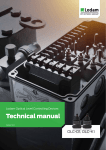
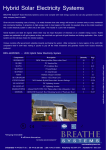

![Manual[DOWNLOAD]](http://vs1.manualzilla.com/store/data/005897454_1-7b43247b19e54aa42c3777609ebafaf8-150x150.png)
